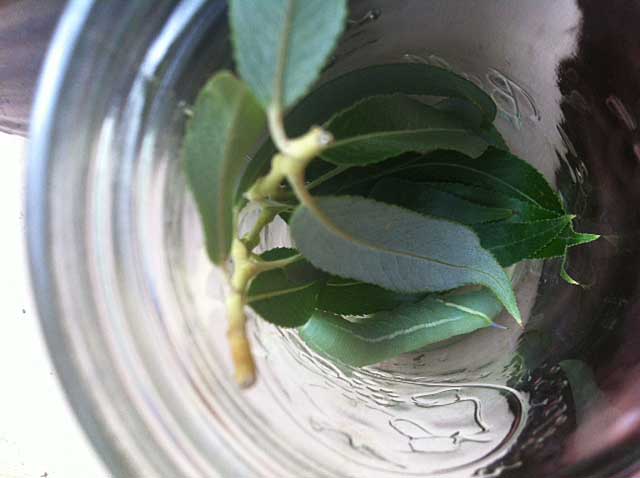
Smerinthus ophthalmica, Taos County, New Mexico,
June 30, 2013, courtesy of Kristie W.
|
|
Inspired by and dedicated to Kristie W. (Smerinthus ophthalmica; June 30, 2013); July 1, 2013 Updated as per James P. Tuttle's The Hawk Moths of North America; July 1, 2013 Updated as per BAMONA; July 1, 2013 |

Smerinthus ophthalmica, Taos County, New Mexico,
June 30, 2013, courtesy of Kristie W.
The well camouflaged larva is lower than the foliage in the photo.
This page is inspired by and dedicated to Kristie W. who sends the Smerinthus ophthalmica larval image above.
Kristie writes, "Hello, Bill,
"I recently visited your silkmoths [Sphingidae] identification guide online and was hoping you could help me regarding a caterpillar I found.
"From your site, it seems to be a Cerisy's Sphinx (photos attached). This was found in Taos, NM, and fell out of a willow tree during a wind storm. It's about
three inches long and less than half an inch wide -- right now, it's in a small jam jar.
"Anyway, I was wondering if you would recommend just putting it back in the tree -- or if it would be OK to try and rear it in captivity. It's just so windy out
here and I wonder if I could help increase its chances of survival.
"Unless, it's ready to pupate? It's not eating any of the willow leaves in the jar. Should I put it back on the ground outside?
"If you have any advice, I'd appreciate it. Thanks again for your helpful web site."
I reply, "Hi Kristie,
"Yes, it is Smerinthus cerisyi. I think it is probably ready to pupate.
"I wish permission to post photo, credited to you, to a Taos County thumbnail page I will create, similar to
McKinley County page at http://www.silkmoths.bizland.com/nmMcKinleysphlarva.htm.
"There is a link for care of found larvae on the McKinley County page.
"Give it another tweklve hours in with willow foliage. If it has done no eating, it is probably ready to pupate.
"Best of luck."
Thirty-five Sphingidae species are listed for New Mexico on the BAMONA website. Not all of the species are reported or anticipated in Taos County. As of July 1, 2013, five are reported for Taos County: Manduca quinquemaculatus; Smerinthus cerisyi; Sphinx libocedrus; Eumorpha achemon; Hyles lineata.
It is hoped that this checklist, with the thumbnails and notes, will help you quickly identify the moths/larvae you are likely to encounter.
A "BAMONA" indicates the moth is reported on the BAMONA website and/or in Lepidoptera of North America, #1. Distribution of Silkmoths (Saturniidae) and Hawkmoths (Sphingidae) of Eastern North America, an excellent little booklet available through Paul Opler.
I, William Oehlke (WO), have added a number of species whose presence I expect in Taos County.
Please help me develop this list with improved, documented accuracy by sending sightings (species, date, location), preferably with an electronic image, via email to Bill Oehlke.
Please also report your sightings to BAMONA, an excellent online resource.
Sphinginae subfamily
Smerinthini Tribe:
Macroglossinae subfamilyDilophonotini tribe:
Philampelini tribe:
Macroglossini tribe:
|
Use your browser "Back" button to return to the previous page.
This page is brought to you by Bill Oehlke and the WLSS. Pages are on space rented from Bizland. If you would like to become a "Patron of the Sphingidae Site", contact Bill.
Please send sightings/images to Bill. I will do my best to respond to requests for identification help.
Enjoy one of nature's wonderments: Live Saturniidae (Giant Silkmoth) cocoons.